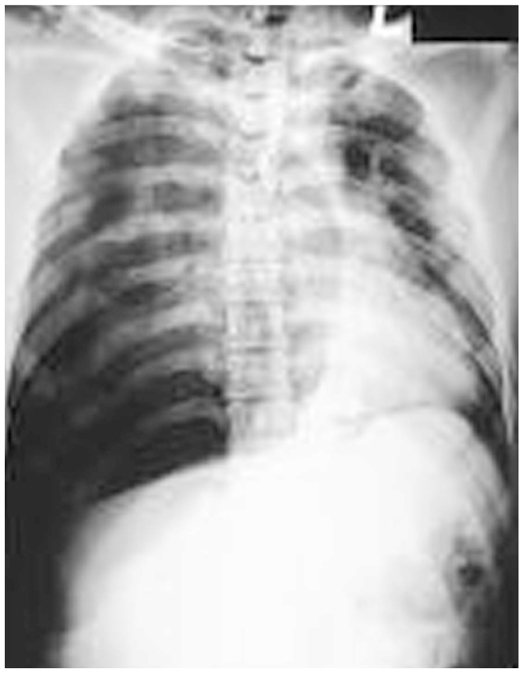J Korean Med Assoc.
2007 Aug;50(8):702-710. 10.5124/jkma.2007.50.8.702.
Emergency Management of Thoracic Trauma
- Affiliations
-
- 1Department of Emergency Medicine, Chonnam National University College of Medicine, Korea. minyi46@naver.com
- KMID: 2184897
- DOI: http://doi.org/10.5124/jkma.2007.50.8.702
Abstract
- The chest is frequently injured by both penetrating and blunt trauma. The vast majority of thoracic trauma patients do not require thoracotomy and are successfully managed by tube thoracostomy and supportive measures. A critical diagnostic challenge in patients with thoracic trauma is the possibility of a life-threatening injury. Specific life-threatening thoracic injuries should be suspected, diagnosed, and treated during the initial primary survey. These are airway obstruction, tension pneumothorax, cardiac tamponade, massive hemothorax, open pneumothorax, and frail chest.
Keyword
MeSH Terms
Figure
Reference
-
1. LoCicero J, Mattox KL. Epidemiology of chest trauma. Surg Clin North Am. 1989. 69:15–19.
Article2. Buchman TG, Hall BL, Bowling WM, Kelen GD. Tintinalli JE, Kellen GD, Stapczynski JS, editors. Thoracic trauma. Emergency medicine. A comprehensive study guide. 2004. 6th ed. New York: McGraw-Hill;1595–1613.3. Exadaktylos AK, Sclabas G, Schmid SW, Schaller B, Zimmermann H. Do we really need routine computed tomographic scanning in the primary evaluation of blunt chest trauma in patients with "normal" chest radiograph? J Trauma Injury Infect Crit Care. 2001. 51:1173–1176.
Article4. Eckstein M, Suyehara D. Prehospital needle thoracostomy. Prehosp Emerg Care. 1998. 2:132–135.5. Richardson JD, Miller FB. Feliciano DV, Moore EE, Mattox KL, editors. Injury to the lung and pleura. Trauma. 1996. 3rd ed. Stamford: Appleton & Lange;387–407.6. Jones NS. An audit of the management of 250 patients with chest trauma in a regional thoracic surgical centre. Arch Emerg Med. 1989. 6:97–106.
Article7. Heare MM, Heare TC, Gillespy T. Diagnostic imaging of pelvic and chest wall trauma. Radiol Clin North Am. 1989. 27:873–879.8. Asensio JA, Arroyo H, Volez W, Forno W, Gambaro E, Roldan GA. Penetrating thoracoabdominal injuries: Ongoing dilemma-which cavity and when? World J Surg. 2002. 26:539–543.
Article9. Rozycki GS, Feliciano DV, Schmidt JA, Cushman JG, Sisley AC, Ingram W, Ansley JD. The role of surgeon-performed ultrasound in patients with possible cardiac wounds. Ann Surg. 1996. 223:737–746.
Article10. Ma OJ, Mateer JR, Ogata M, Kefer MP, Wittmann D, Aprahamian C. Prospective analysis of a rapid trauma ultra sound examination performed by emergency physicians. J Trauma. 1995. 38:879–885.11. Richardson JD, Spain DA. Mattox KL, Feliciano DV, Moore EE, editors. Injury to the lung and pleura. Trauma. 2003. 4th ed. New York: McGraw-Hill;188–201.12. Brown J, Grover FL. Trauma to the heart. Chest Surg Clin North Am. 1997. 7:325–341.13. Wise D, Davis G, Coats T, Lockey D, Hyde J, Good A. Emergency thoracotomy: "How to do it". Emerg Med J. 2005. 22:22–24.
Article14. Fabian TC, Davis KA, Gavant ML, Croce MA, Melton SM, Patton JH Jr, Haan CK, Weiman DS, Pate JW. Prospective study of blunt aortic injury: Helical CT is diagnostic and antihypertensive therapy reduces rupture. Ann Surg. 1998. 227:666–677.15. Eckstein M, Henderson S. Marx JA, Hockberger RS, Walls RM, editors. Thoracic trauma. Rosen's emergency medicine. Concejpts and clinical practice. 2006. 6th ed. Philadelphia: Mosby;453–488.
Article16. Gupta A, Jamshidi M, Rubin JR. Traumatic first rib fracture: Is angiography necessary? A review of 730 cases. Cardiovasc Surg. 1997. 5:48–53.
Article
- Full Text Links
- Actions
-
Cited
- CITED
-
- Close
- Share
- Similar articles
-
- A Review of Quality Management and Improvement of Trauma Fee Schedule in Regional Trauma Center
- Effect of the Emergency Trauma Team's Management on the Treatment of Patients with Multiple Severe Trauma
- A Case of the Pneumopericardium Following Blunt Chest Trauma
- How to Set Up the Advanced Trauma Life Support in Korea?
- Analysis of Characteristics of Thoracic Injury Patients and Nursing Interventions Using Nursing Intervention Classification by Emergency Room Type



